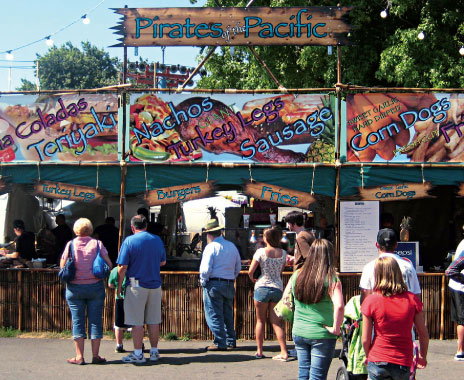With summer approaching, quick-serve operators are preparing to go where their customers go in an effort to boost seasonal revenue. For some brands, that means setting up shop at fairs and other summer festivals, which offer exposure to potential new customers and room for creativity with menu development and marketing.
“People are walking around with a handful of money, and they want to give it to you,” says Carey Risinger, senior vice president of foodservice at the State Fair of Texas.
After debuting at his first farmers market last June, Jon Turner, co-owner of Des Moines, Iowa–based Parlo Pizza, got an opportunity to take his concept to the Iowa State Fair. For the fairground, Parlo Pizza offers limited ingredients for wood-fired creations—a limited menu means the team can dish out pizzas quickly—but gives them flair, Turner says, as flavor still rules at events like a fair. A decades-old family recipe for hot sausage, for example, helps the concept stand out among hundreds of other vendors. Parlo Pizza also takes advantage of local flavors to increase appeal.
“In Iowa, we like bacon,” Turner says. “So we have a hot sausage and bacon pizza.”
During large fairs, foodservice vendors may see an average of 10,000 or more customers a day, Turner says, and menu items may need to be modified or entirely reworked to translate into success with fairgoers. To meet Iowa State Fair regulations, Turner purchased a 10-by-12-foot meat locker kit and modified it to meet his needs. Anticipating additional events this year, the Parlo Pizza team plans to buy a vending trailer that won’t require much setup or breakdown time, he adds.
Fair food is expected to be new and different, says Cyndi Ail, owner of Ail Food Concessions, which is headquartered in Salem, Oregon. Unusual goodies are one thing she uses to get an edge, and her recent innovations include deep-fried Twinkies, Oreos, Snickers, and Kool-Aid.
“That’s our gimmick to get people to come to our booth or to get a fair that wants us, because it’s new and it’s great,” Ail says. She also serves traditional elephant ears, funnel cake, and corn dogs, but tries to add a twist where possible. “Our sweet garlic corn dogs are my grandfather’s recipe,” she says, adding that fairground food is competitive, and “you have to have that little push to get in there.”
Not every dish is as good a fit at a fair as it seems, says Jeff Renaud, director of sales and marketing at La Coppa Artisan Gelato, which participates in the Wisconsin State Fair and has three branded cafés across the state. Gelato, for example, isn’t necessarily always a slam-dunk, despite being a cold treat on hot days.
“It does take a little bit of inventing on our side to be able to bring a product like ours to a fairground,” he says.
Uniqueness of the food offerings is one thing Risinger says his team considers when evaluating applications from new foodservice operators for the State Fair of Texas. Risinger says he often forgoes concepts touting classic items like turkey legs, nachos, funnel cake, or cotton candy, opting instead for dishes like crepes and pie shakes, both of which were added through new vendors last year.
“Take a piece of pie, drop it in a shake cup, put it on the spindle, and you have a coconut cream pie shake,” Risinger says of one of the fair’s most recent additions.
Operating at fairs and festivals comes with a host of challenges. Staffing, for example, is a tricky task, requiring brands to plan for both lulls during events and multiple events happening simultaneously. La Coppa usually hires seasonal staff, some of whom end up staying on to work in the restaurants the rest of the year. But a typical fair worker needs a different personality to succeed, with charisma being a primary necessity, Renaud says.
“You need employees who are three times more enthusiastic and more vocal—and are strong salesmen—than you do in your cafés,” he says. “At a festival, you’re really working for it.”
The State Fair of Texas is a show, Risinger says, and how concessionaires present themselves and their food to fairgoers is key. If the staff isn’t cheerful and doesn’t make every effort to entice customers, they’ll likely be passed over.
While the list of challenges facing brands who set up shop at a fair or festival extends into the minutia of translating a brand to a field unit—“One of the major hurdles is just being able to do what you normally do in a remote location,” Renaud says—not every operator even makes it that far. Fees and regulations make entering the space difficult.
The Oregon State Fair, for example, is one venue with several entry policies. “You have to have a restaurant or be in the food business, or have worked at other fairs for … two or three years before you can even get in,” Ail says.
Risinger says entry costs at fairs can be upward of $30,000. He adds that many organizations charge concessionaires 23.5 percent or more of gross sales. Add on insurance, which is required by nearly all events; health permits; and parking credentials, and the price of admission makes a fairground a difficult environment to break into, he says.











